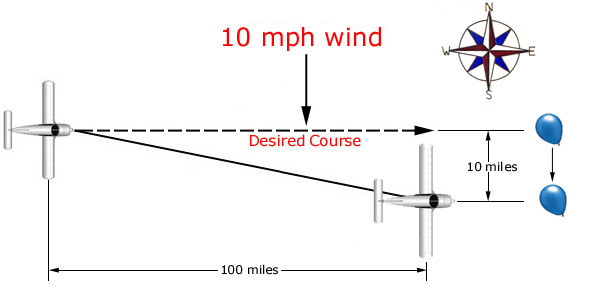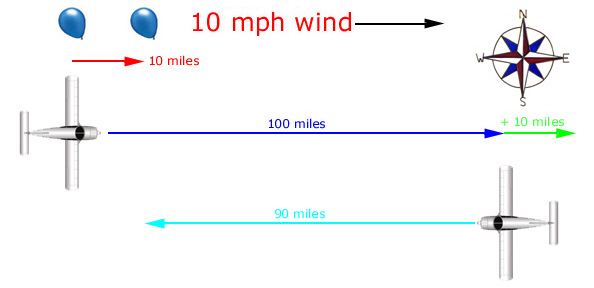
|
 |
||||||
|---|---|---|---|---|---|---|---|
| Wind Effect |
 |
 |
 |
 |
 |
||
 |
 |
 |
 |
 |
|||
 |
||
|
During flight, one of the main considerations that will affect an aircraft is the motion of the wind. Referred to as wind effect, the speed and direction of the wind will alter the progress of any aircraft in flight. Although an aircraft has its own means of propulsion, the pilot must compensate for the wind speed and direction, in order for an aircraft to maintain the desired course.
If we were to take a simple balloon, with no means of propulsion, and let it float freely in the air, the balloon will drift at the same speed and direction in which the wind is moving. If the air is moving at 10 mph in a southerly direction, after one hour, the balloon will drift 10 miles south. Now if we were to fly an airplane straight and level at 100 mph for one hour heading due east, the aircraft will be 100 miles east of its starting point after one hour, but it will also drift south 10 miles (the same as the balloon), if the pilot does not correct for the wind. When the wind is moving towards an aircraft from an angle, this will cause what is referred to as wind drift. For more information on this topic, refer to the page on wind drift.

Again if we were to take the same balloon, (with no means of propulsion, and let it float freely in the air), with the air moving at 10 mph in an easterly direction, after one hour, the balloon will drift 10 miles east. Now if we were to fly an aircraft at 100 mph for one hour, heading due east, the aircraft will be a distance of 110 miles east of its starting point. The aircraft was again affected by the wind just as the balloon was. The aircraft flew 100 mph under its own power, but it also was able to gain an additional 10 miles in distance, because it was carried along by the wind, that was moving as the same direction as the aircraft. This is called a tailwind. If the aircraft were to fly west under the same conditions, after one hour the aircraft would have flown only a distance of 90 miles. This time the aircraft was flying directly into the wind and the wind speed is subtracted from the aircraft speed. In this case the aircraft is said to be flying into a headwind. When a headwind is subtracted or a tailwind is added to the speed of an airplane, this is called the wind component and will affect only the ground speed and not the actual airspeed of the aircraft. In this example, the airspeed will always read 100 mph, but if the aircraft is affected by a tailwind or headwind component, we must add or subtract the wind speed to find the actual progress or ground speed of the aircraft. For instructions on how to calculate this, refer to the page on ground speed. |
Return to Aircraft Theory Index
© The Aviation History Online Museum. All rights reserved.
Created December 14, 2009. Updated June 1, 2015.